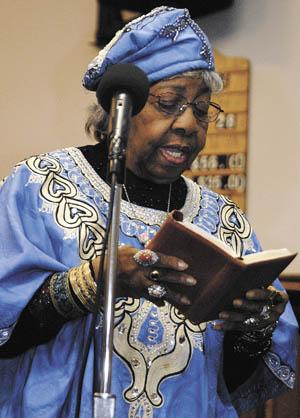Celebrating the 40th Anniversary of Kwanzaa
Published 12:00 am Thursday, December 28, 2006

- Lara Cooper/Daily NewsJoy Day of Bowling Green reads Scripture during Wednesday night's Kwanzaa celebration at Taylor Chapel AME Church.
Wednesday night, the close-knit community of Taylor Chapel AME Church gathered at its sanctuary at 503 Clay St. to celebrate Kwanzaa, the church’s fifth year of marking the holiday millions of African-Americans and those in the African Diaspora worldwide observe every year.
Kwanzaa, a Swahili word meaning “first fruits of the harvest,” is a celebration based on African traditions when farming communities come together to celebrate the harvest, according to Saundra Starks, an associate professor of social work at Western Kentucky University who led and explained the meaning of the ceremony to a crowd of 60 or more people in attendance.
Trending
Starks said Kwanzaa is a holiday that lasts seven days – with each day representing one of seven principles – along with symbols that reinforce traditions and values all should live by.
Today is the third day of Kwanzaa, Ujima, which means collective work and responsibility, a day Starks said reinforces the “it takes a village” mentality people should take when viewing their role in their community.
Kwanzaa was created in 1966 by Maulana Karenga, a professor of Black Studies at California State University, after Karenga visited East Africa, according to John Hardin, an associate professor of history at Western Kentucky University.
“He took the various traditions and took the traditions that were common to many different groups. He did not want to make it commercial,” Hardin said. “Karenga chose seven days for us to think about what we have done in the year.”
Bowling Green’s ceremony fell on the second day of Kwanzaa, Kuchichagulia, which is Swahili for self-determination.
Starks said that celebrating Kwanzaa is one step toward recovering one’s heritage.
Trending
After the ceremony, those in attendance were able to ask questions.
“Does (Kwanzaa) relate to the birth of Jesus?” church member Sylvester Ingram asked.
“It’s not a religious holiday, but it’s a spiritual holiday that is based on principles that we need to live by,” Starks answered.
The Rev. William Hardy, pastor of Taylor Chapel and associate professor of philosophy at Tennessee State University, said that many African-Americans today choose to celebrate Kwanzaa in order to regain cultural identity and common ideals.
“We should reclaim what has been taken from us. Why don’t we know more about ourselves?” Hardy said.
“Some of us don’t know who we really are,” Ingram said. “I would like to know more about it myself. I am interested in where I came from.”
While not religious, Kwanzaa is a cultural holiday that has become religious, Hardin said.
“It is hard to separate religion from where we are as a people,” Hardin said. “We are a religious people.”
Hardin said the celebration of Kwanzaa has evolved starting off with small “get-togethers” and later becoming a commemorative postage stamp.
“What (Karenga) has tried to do is connect with Africa in a positive way rather than negative. There is more to Africa than war,” Hardin said. “It’s to the point now where it’s fitting into a cycle of events; it’s Hannukah, then Christmas, then Kwanzaa, then New Year’s Eve.”
Hardin said that Kwanzaa synthesizes the language of Swahili, an East Africa language used in business dealings, and represents a way for people to connect to the spiritual things of Africa – not to a specific country.
This year marked the 40th anniversary for Kwanzaa.
Karenga encouraged people to “expand the moral imagination of society and the world,” for this year’s founder’s message, found on the holiday’s official Web site, www.OfficialKwanzaaWebsite.org.
“And let us keep the good faith of our forefathers and mothers, steadfastly devoted to justice, self-consciously open to sharing and profoundly committed to that ancient and ongoing ethical mandate to constantly strive and struggle to make good ever more present and powerful in the world. Heri za Kwanzaa (Happy Kwanzaa),” Karenga wrote.
NGUZO SABA (The Seven Principles)
Umoja (Unity): To strive for and maintain unity in the family, community, nation and race.
Kujichagulia (Self-Determination): To define ourselves, name ourselves, create for ourselves and speak for ourselves.
Ujima (Collective Work and Responsibility): To build and maintain our community together and make our brothers’ and sisters’ problems our problems and to solve them together.
Ujamaa (Cooperative Economics): To build and maintain our own stores, shops and other businesses and to profit from them together.
Nia (Purpose): To make our collective vocation the building and developing of our community in order to restore our people to their traditional greatness.
Kuumba (Creativity): To do always as much as we can, in the way we can, in order to leave our community more beautiful and beneficial than we inherited it.
Imani (Faith): To believe with all our heart in our people, our parents, our teachers, our leaders and the righteousness and victory of our struggle.
– Maulana Karenga
The Symbols of Kwanzaa
Kwanzaa has seven basic symbols and two supplemental ones. Each represents values and concepts reflective of African culture and contributive to community building and reinforcement. The basic symbols in Swahili and then in English are:
Mazao (The Crops)
Symbolizes African harvest celebrations and of the rewards of productive and collective labor.
Mkeka (The Mat)
Symbolizes tradition and history and therefore, the foundation on which the world is built.
Kinara (The Candle Holder)
Symbolizes the roots or parent people – continental Africans.
Muhindi (The Corn)
Symbolizes children and the future.
Mishumaa Saba (The Seven Candles)
Symbolizes the Nguzo Saba, the Seven Principles, the matrix and minimum set of values which African people are urged to live by in order to rescue and reconstruct their lives in their own image and according to their own needs.
Kikombe cha Umoja (The Unity Cup)
Symbolizes the foundational principle and practice of unity which makes all else possible.
Zawadi (The Gifts)
Symbolizes the labor and love of parents and the commitments made and kept by the children.
The two supplemental symbols are:
-Bendera (The Flag)
The colors of the Kwanzaa flag are black, red and green; black for the people, red for their struggle and green for the future and hope that comes from their struggle. It is based on the colors given by the Hon. Marcus Garvey as national colors for African people throughout the world.
-Nguzo Saba Poster (Poster of The Seven Principles)







